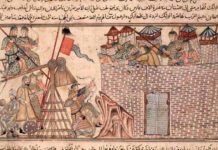King Sejong was the fourth king of the Yi dynasty of Korea, which was the dynasty that ruled the country from 1392-1910. He was born in 1397 and ruled from 1412-50. Sejong is recognized as one of Korea’s greatest kings and his most well-known achievement was the introduction of the Korean script, Hangul. Hangul is a script of 24 letters, 10 of which are vowels and 14 consonants. It is an almost entirely phonetic language and is exceptionally easy to learn and write: indeed, there is no real phrase in the Korean language for “How do you spell …?”
Korea at the beginning of the Yi dynasty was dominated by the influence of Chinese culture, Confucianism and Buddhist priests. While he wanted to retain the religious nature of the court, Sejong banished the Buddhist priests from the capital Seoul because they had too strong a stranglehold on learning and prevented ordinary people obtaining access to civil service posts and the possibility of advancement. Just as importantly, the Korean people were unable to express themselves and explain their opinions and emotions because understanding of the Chinese language and the characters it used were restricted to a small elite and the majority of people had to rely on informal language and slang.
King Sejong’s purpose, therefore, was to broaden understanding of a genuine Korean form of expression which would be available to all Korean people and which would, at the same time, help to free them from forms of thinking imposed upon them by having to use an alien language. This would also help to reinforce a sense of independence for the Korean nation. Sejong also introduced rules permitting scholars and civil servants to drink alcohol and, occasionally at least, consort with women. This made the role of scholar rather more attractive and helped free it from a religious stranglehold. By opening the position of scholar to a potentially much larger body of applicants, therefore, Sejong was responsible for much more democratic access to power and enabled the brightest talents in the kingdom to be of service to the state.
To demonstrate the practicality of Hangul as a language and medium, Sejong himself composed the ‘Songs of the Moon’s Reflection on a Thousand Rivers’ [worin chongang chingok] which praised the life of the Buddha and exemplified the new akchang form of literary expression: creating new forms of artistic endeavour was particularly important because Hangul does not provide the opportunities for calligraphy that Chinese characters do.
October 10th, 1446 is remembered as the day on which Hangul was introduced. However, owing to continued influence and presence of a powerful ruling class, it only really became the official language after 1945, when the Japanese who had colonized the country since 1910 (ending the Yi dynasty) were finally driven out of the peninsula.








